
8 Best Enterprise Low-Code Development Tools
Do you want to find out which are considered top enterprise low-code platforms? This article explores the best ones on the market that will help you scale your projects and business practices.
Low-code development platforms aren’t going away, no matter how skeptical developers (and development managers) are at the thought of implementing such tools into their process. These automation technologies have already reached a point where using them in modern-day app development is inevitable. Especially now, when time-to-market is a critical business advantage, digital product teams are using every tool they can to deliver streamlined software solutions in significantly shorter time periods than ever before.
Business leaders are looking to low-code development tools to increase delivery speed, and at the same time, to establish a more agile enterprise. Low-code tools are based on the promise of “ease of use” for almost any type of developer – professional or citizen developer. They are designed to be accessible, with component-based WYSIWG that can address software developer supply shortage and more easily and naturally foster scalability, application democratization, productivity, and agility.
We won’t go too deep into the definition of low-code development and what a low-code platform is as we have already published two highly insightful and valuable articles – “Low-Code Development vs. No-Code Development: Which to Choose” and “What is Low Code Development and Why is it Important?”
They provide thorough information, answer key questions, compare and contrast traditional app development vs low-code development, and highlight the advantages and disadvantages of these tools for the development team.
Instead, this blog post will focus on the importance of low-code development for the enterprise and how business owners benefit from integrating these types of app accelerators and automation platforms.
What Is Low-Code Development and a Low-Code Platform?
Low-code development allows IT professionals as well as programmers with little coding experience to build their apps without having to write code line by line. Instead, they rely on low-code platforms that usually provide a comprehensive library of UI controls, reusable drag-and-drop components, pre-built app templates, and additional options for customization and branding.
From a business perspective, low-code development is a way to catch up (and keep pace) with the ever-growing demand for more innovations for significantly larger industries (biotech, fintech, clinical research, science, culture and entertainment, and more); handle the shortage of software developers; undergo digital transformation; grow your business value and increase ROI.
When To Use an Enterprise Low-Code Platform for Your Business?
- If you want to make your IT department work better
Low-code tools give IT departments more flexibility in terms of resource allocation and agility. No longer does management need to look at their application backlog with no hope of achieving even 1/3 of what’s being asked of them. With low-code tools, they can deliver more applications faster, with more speed, less bugs and drive satisfaction to the business units that depend on their skills. Low-code tools also allows IT departments to use cloud services in new, incremental ways, off-loading the provisioning and maintenance of on-premises hardware to the cloud, where its less expensive, has high security, and includes service-level agreements for uptime.
- If you want to deliver cross-platform accessibility and democratize app development
Working as a single source of truth, low-code development tools save you crucial time in operations like ideation, communication, collaboration, management, designing, generating production-ready code, developing, deploying, testing, upgrading, documentation, and marketing a given product.
- To overcome business challenges like the shortage of experienced IT professionals
In the latest Reveal “Top Software Development Challenges for 2022” survey released by Infragistics, 53% of the software developers and IT professionals who responded highlighted that recruiting programmers with the right skill set will be the biggest business challenge this year.
“Other major difficulties identified in the Reveal survey include struggles maintaining current talent (46%) and not enough time to get work done (31%). More than a third (40%) of software industry professionals are facing increased customer demands, and 39% are working with limited resources (lack of budget, unable to maintain software).”
According to a recent survey by Mckinsey, the business areas that experience the shortage impact the most are:
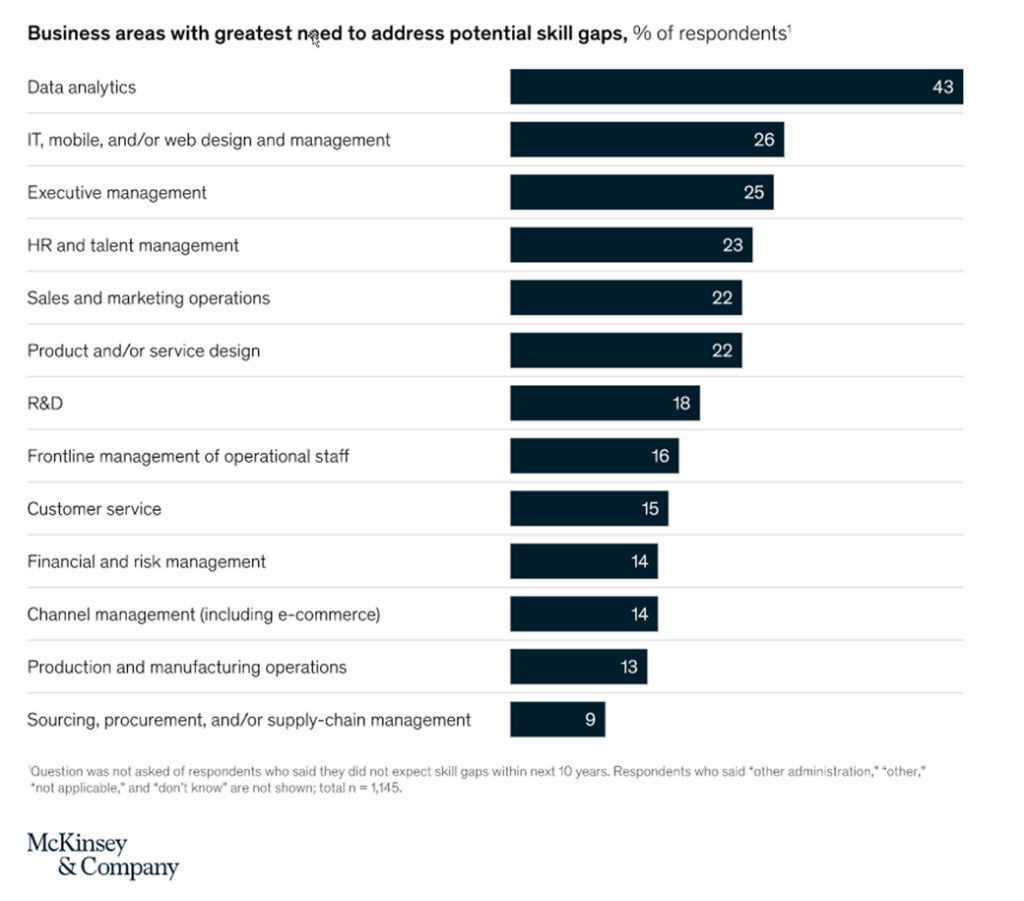
Figure 1: McKinsey & Company Survey Results on Skills Gaps
With the implementation of low-code tools in your business, you address key business challenges for 2023 as software developer shortage and IT talent gaps.
Jason Beres, our Sr. VP of Developer Tools, highlights that; “The pandemic highlighted one of the most crucial challenges facing the software industry — the need for more professional software developers. With the latest iteration of low-code/no-code tools, both professionals and citizen developers can create new applications, enhance existing ones and automate complex tasks. This will alleviate some of the pain being felt by organizations facing a worldwide shortage of full-time developers.”
- In case you’re planning to establish more agile and composable enterprise model
In their Future of Applications: Delivering the Composable Enterprise report[1], Gartner explain that “a composable enterprise is an organization that can innovate and adapt to changing business needs through the assembly and combination of packaged business capabilities.” These capabilities can be extracted from low-code tools to generate better, intuitive, and hyper-personalized user experiences within given apps while simultaneously facilitating deeper collaboration between designers, developers, stakeholders, and fusion teams.
It’s becoming essential that your company and business adapt to the hyper-digitalization happening now in a quick and effective way. And it’s becoming popular now for business owners to try to establish a “composable enterprise model”, utilizing automation tools, just like the low-code platforms.
This composable paradigm is what helps them stimulate highly adaptive working practices, adopt co-creation methodologies, and leverage data. In addition, the composable enterprise model simultaneously provides business owners and their IT department with the ability to apply development processes either independently or interchangeably, speeding up the entire product time-to-market. Which becomes a great way for harnessing micro or macro business as well as DevOps changes that have an enterprise-wide impact or affect only a single operation.
- When driving better business intelligence is mandatory
Some enterprise low-code development platforms are packed with comprehensive data engineering capabilities that facilitate your Business Intelligence strategies. There are options that make it super easy for your teams to process, store, generate, and analyze important data in real time, helping you make informative decisions for your business, people, and software development operations in general.
What Are the 8 Best Enterprise Low-Code Development Platforms?
App Builder
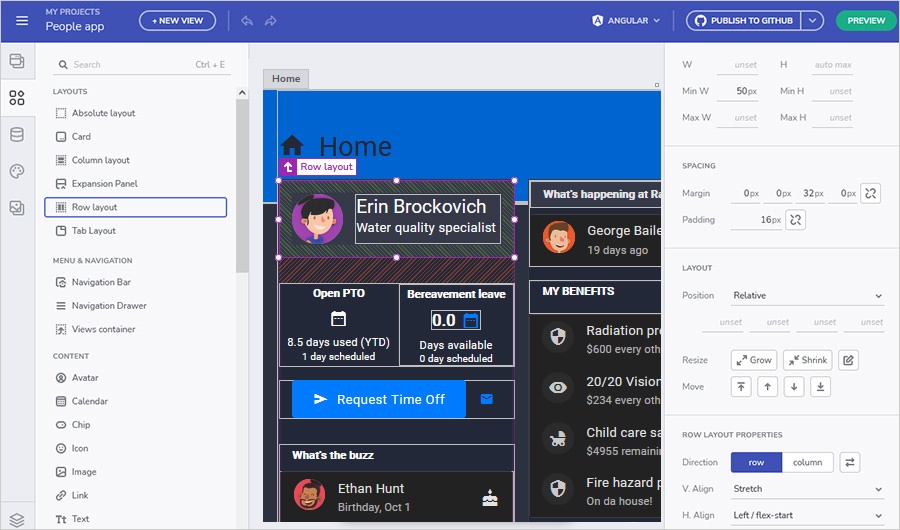
Overview: A low-code WYSIWYG app development tool that streamlines everything from design to code. It is crafted for businesses of all sizes so they can build modern-day software solutions faster, create a single source of truth for everyone, streamline collaboration, make data-driven decisions, and undergo digital transformation smoothly by automating key processes using DesignOps and DevOps. Most of its components arrive with built-in presets to support common usage scenarios. The Cloud-based drag-and-drop App Builder(tm) from Infragistics also includes pre-built applications and layout templates, so your developers can get started with a functional app shell.
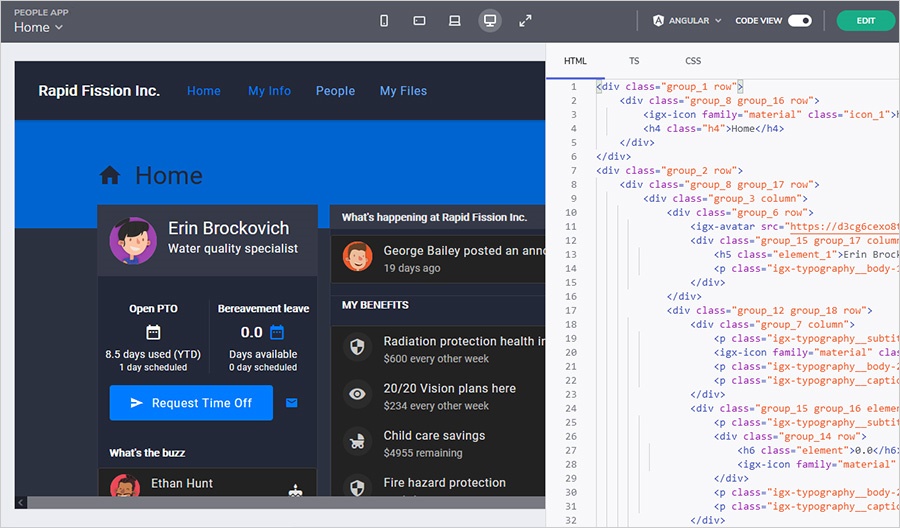
Key features:
- Intuitive interface
- Flex layouts
- 60+ UI controls and options to modify the position of the nested UI elements
- Flexible and reusable quick-add components
- Interactions that can be set up between components and views or just between components
- Data binding
- User and usability testing
- A complete Design System – Indigo.Design
- Pre-built themes (Material, Bootstrap & Fluent), configurable panels, styles, typography, and more
- Single-page/master-detail apps creation and rich navigation with routing
- HTML, TypeScript & CSS for Angular and Razor and CSS for Blazor, plus Web Components code
- Instant code preview that lets you interact with the design to check how the running app will look, feel, and work
- GitHub integration of the generated code output
- Ability to create apps from existing designs, Sample apps, Default layouts, or from scratch
- Ability to convert Sketch and Figma design files into code
All about its features and capabilities – in the App Builder product overview and tutorial below.
Best for: building enterprise-grade apps, e-commerce apps, fintech, travel applications, team collaboration; prototyping, user and usability testing; real-time analytics; and composable business strategies. It is ideal for experienced programmers, citizen developers, designers, and stakeholders.
Appian
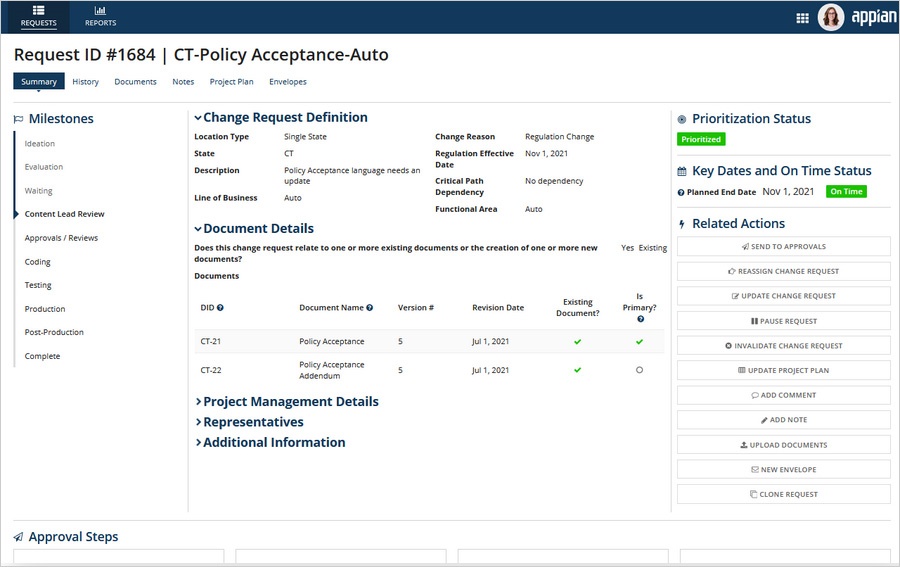
Overview: A low-code platform that has the goal to automate complex processes, unify data, and streamline app development by letting developers simply draw a workflow diagram. It allows users to create custom apps that can be easily deployed on any device. There are several deployment options including cloud-based, on-premises, and hybrid. User-friendly, Appian is used for promoting better collaboration among teams as well.
Key features:
- Dynamic offline mobile and offline UX
- One-click deployment
- Case management
- Social collaboration feature
- Live screen sharing
- Business Process Management (BPM)
- Three-step app development
- Integrates with IoT devices
- Drag and drop actions
- IE11 support
- Robotic process automation features
- Multiuser and multi developer features
- Seamless data integration
- Prebuilt UI frameworks
- Performance monitoring and debugging capabilities
- Ability to view source objects from sites
Best for: developing business process management applications, document management, interactive reports and data analytics
Betty Blocks
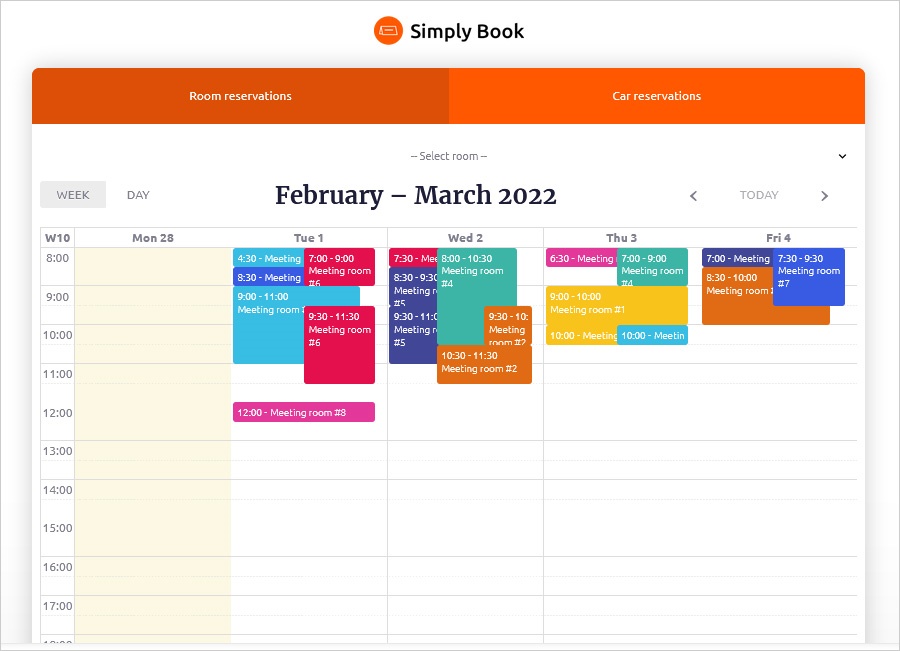
Overview: A no-code drag-and-drop enterprise app development tool that enables users to build app workflows through a visual interface. Supporting fast development and flexibility, Betty Blocks enables parts of the application to be reused in other projects. It is fully web-based, and there is no need for deployment.
Key features:
- Tools and actions to define app logic
- Page builder and visual modeling
- Reusable drag-and-drop blocks
- Connects to all types of web services
- Mailboxes integration
- Fits into an existing architecture
- Data model
- Back office for administering data
- Templates
- Variables
Best for: citizen developers with no coding experience; building apps for engineering and construction, finance, insurance, the legal sector; streamlining app creation
Mendix
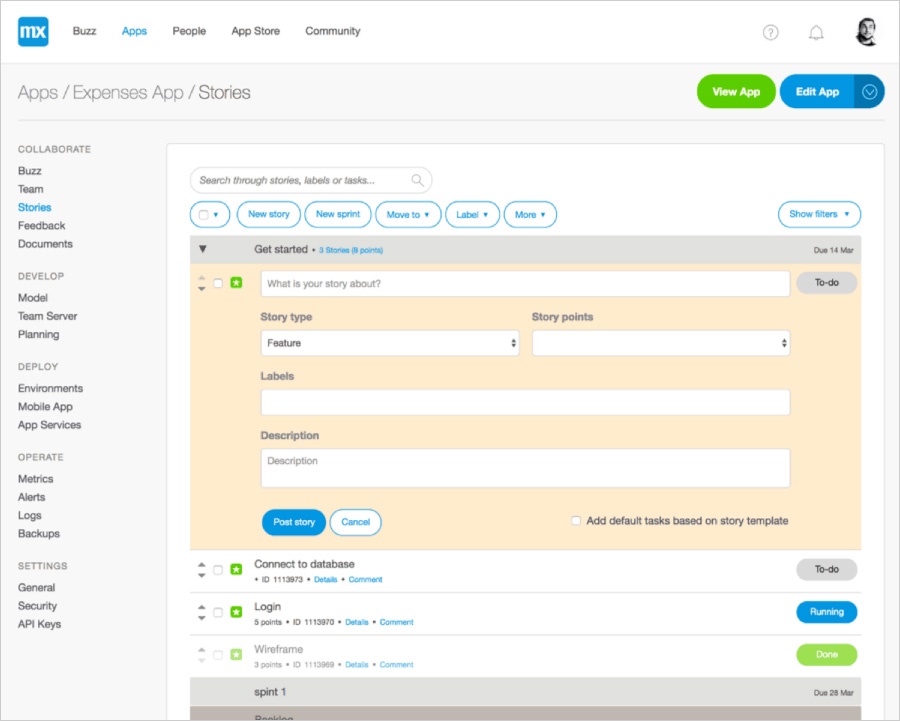
Overview: As a low-code enterprise application platform, Mendix is used for bootstrapping applications from scratch, while providing data-driven architecture. With plenty of integration capabilities and agile development to eliminate the complexity during the software development life cycle. One of the key advantages of this low-code platform is that it allows for multiple apps to be used in a component-based platform through microflows, empowering co-creation.
Key features:
- Library of 400+ building blocks
- Multi-channel apps
- Integrated collaboration tools
- Proactive and context-aware apps management
- Development and operations (DevOps)
- Multi-cloud deployment
- Open and extensible integrations with APIs
- AI assisted development
Best for: bootstrapping ideas, improving business process agility and enterprise process automation, speed up app development
OutSystems
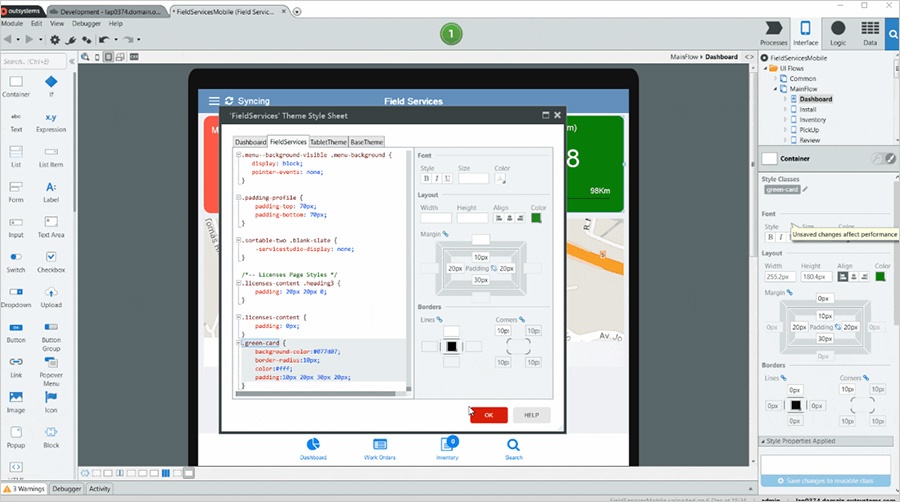
Overview: OutSystems is a full-stack AI-powered app maker that combines the ease of use of low-code functionalities and visual model-driven development capabilities. It is used for building custom UX, streamlining business processes, and improving app logic with the help of drag-and-drop elements. With an intuitive interface, great product performance, and a Rapid Application Development model.
Key features:
- Load balancing and auto-scaling capabilities
- In-app feedback to improve collaboration and help solve business challenges
- Easier integration of existing systems (SaaS, infrastructure, data)
- Code base generation
- Real-time monitoring, reporting, and performance dashboards
- Microservice architecture
- DevOps automation
- Access control and permission management.
- Drag-and-drop builder
- Fully secured functionality
- Integrated debugging engine
- Multilingual support
- Full support for Batch Processes & Scheduling
- Workflow builder
- Pre-built AI components
Best for: mobile app development, creating accessible applications that comply with WCAG 2.1 AA and Section 508, design complex UIs and deploy as reactive web apps, for great experiences on mobile apps and wearables through AR/VR
Pega Express
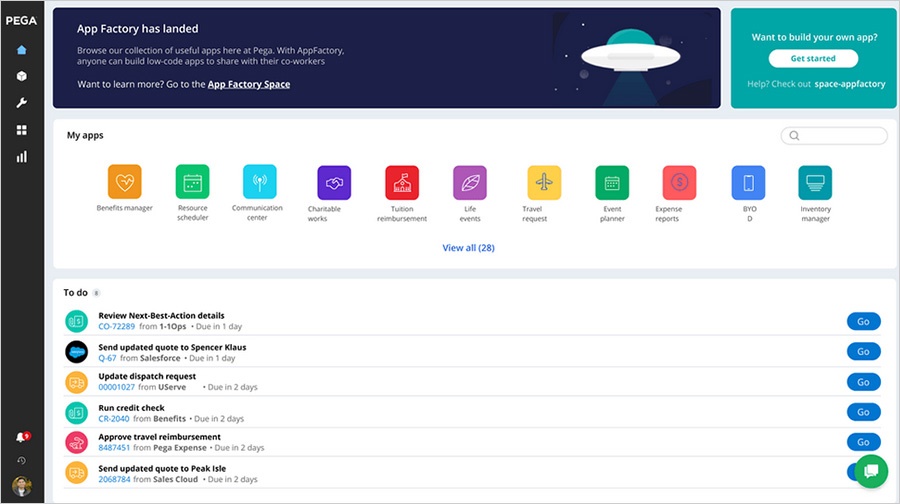
Overview: Pega Express is part of the unified enterprise-level customer relationship management (CRM) platform Pega CRM which delivers digital process automation through their patented attended automation and personal bots. Pega is primary used for robotic process automation (RPA) that automates repetitive tasks and integrates legacy systems, for case management and, as well as for low-code UI development.
Key features:
- Attended and unattended robotic process automation
- Case management and business process management
- Auto-balancing robot resources
- Email bot
- X-ray Vision to reduce upfront effort
- Workforce intelligence using AI
Best for: digitalization and automation of business processes, collaboration and better synced work across departments while building enterprise apps, UI creation
Zoho
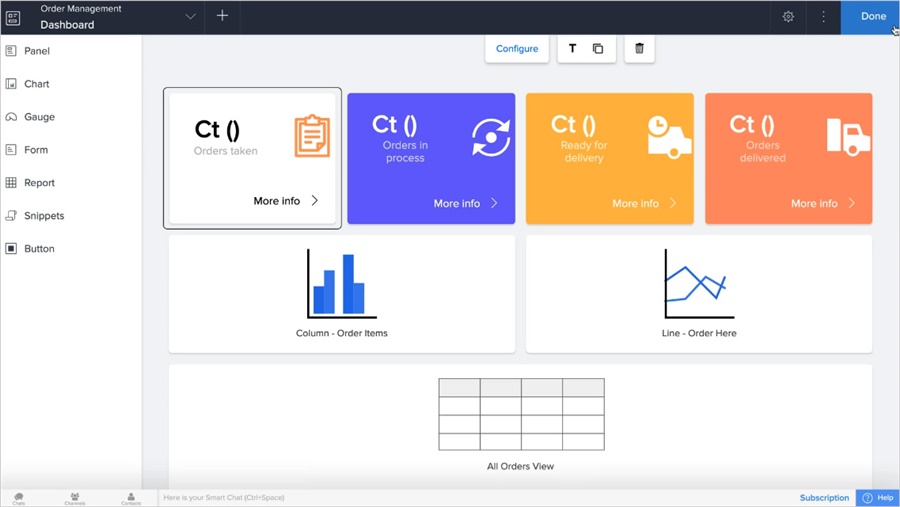
Overview: As a low-code app development platform, Zoho provides a GUI-rich development environment and relies on visual programming principles to streamline app creation. It combines drag-and-drop functionalities and requires little coding to get your project started.
Key features:
- Prebuilt integrations for over 600 apps
- Ability to Create custom UI components and Java libraries
- Role-based access controls for better collaboration
- Real-time reporting and cross-functional data analytics
- Powered by Zoho’s proprietary scripting language – Deluge
- Drag-and-drop interface
- Import data with AI-assisted migration tools
- Third-party apps integration
- Secure sharing, accessing, and collaboration
- REST API
- Automated workflow
- Webform
- Pre-built templates
- Built-in camera, barcode and maps functionality in the BPM tool
Best for: AI-powered apps, mobile apps, online portals, workflow automation, enterprises, SMBs, startups
Anima
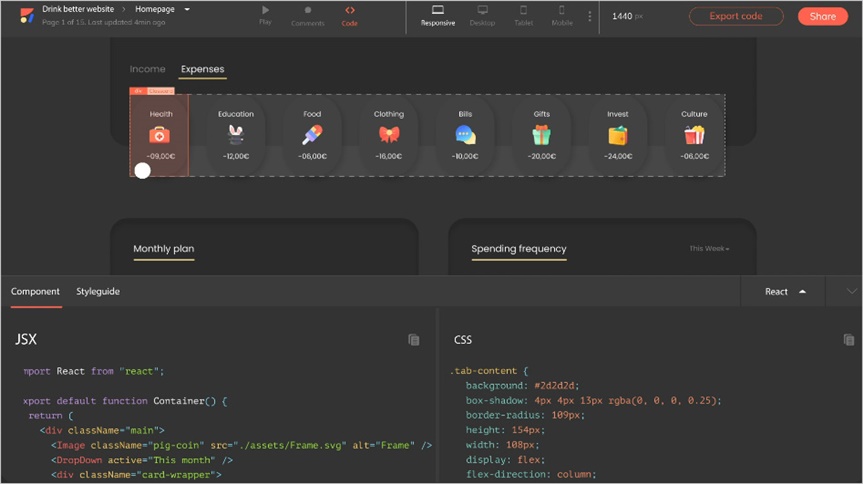
Overview: Another useful low-code tool that is used for creating high-fidelity prototypes and brings together design and programming functions. Anima streamlines development by eliminating designer-development handoff and generating automated front-end code.
Key features:
- Generates React, Vue and HTML code
- Uses a plugin that connects directly to design tools (Sketch, Figma, Adobe XD)
- Provides single source of truth
- Enables smart layers, flow or layout options
- Quick previews in the browser
- Animations, text field, and hover effects
- Designers can share their work with the rest of the team
Best for responsive and interactive high-fidelity prototypes, reducing errors in the designer-developer handoffs
Sources:
Reveal, “Top Software Development Challenges for 2022”
Gartner, “Future of Applications: Delivering the Composable Enterprise Published”, Dennis Gaughan, Yefim Natis, Gene Alvarez, Mark O’Neill, 11 February 2020
McKinsey, “Beyond hiring: How companies are reskilling to address talent gaps”, Sapana Agrawal, Aaron De Smet, Pawel Poplawski, Angelika Reic, February 12, 2020
[1] Gartner, “Future of Applications: Delivering the Composable Enterprise Published”, Dennis Gaughan, Yefim Natis, Gene Alvarez, Mark O’Neill, 11 February 2020

